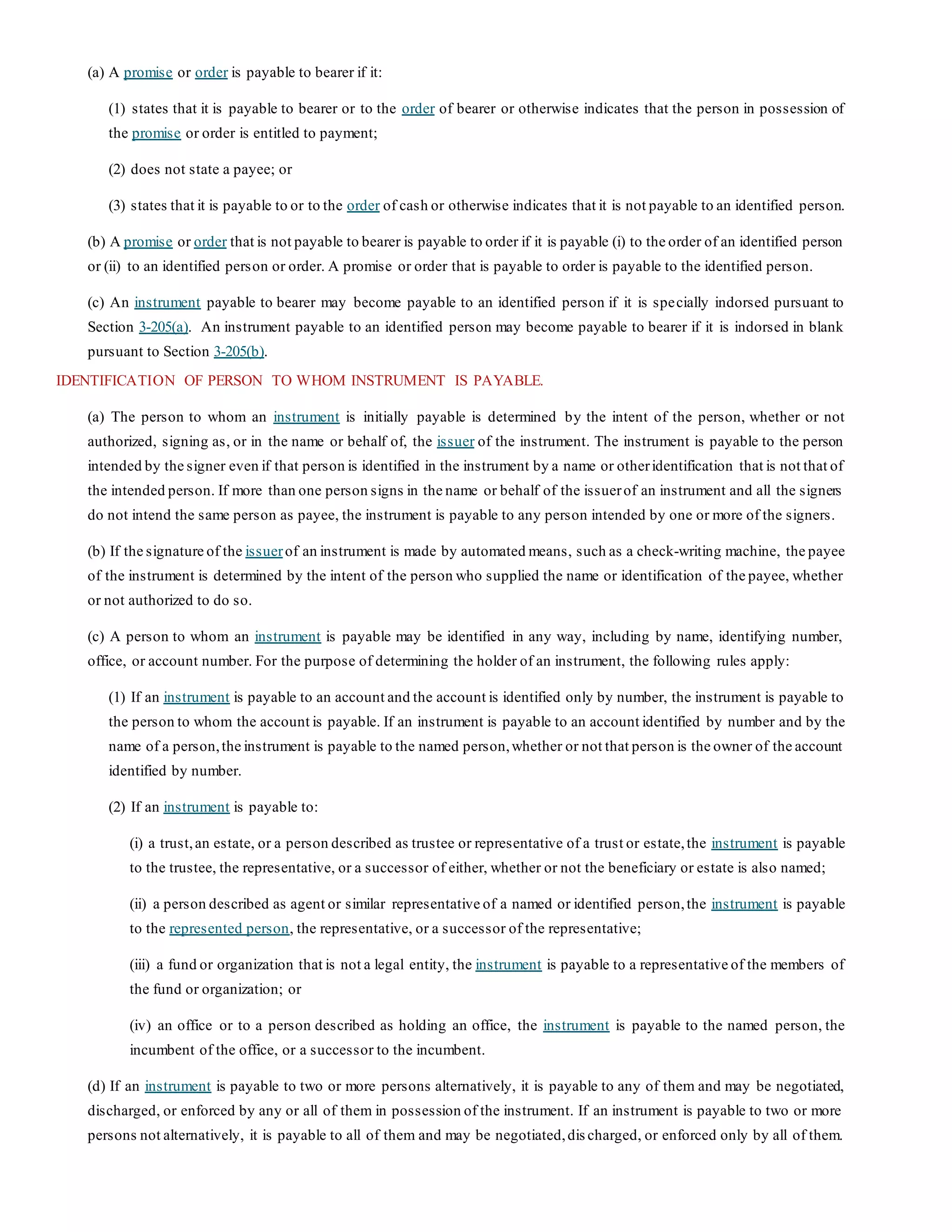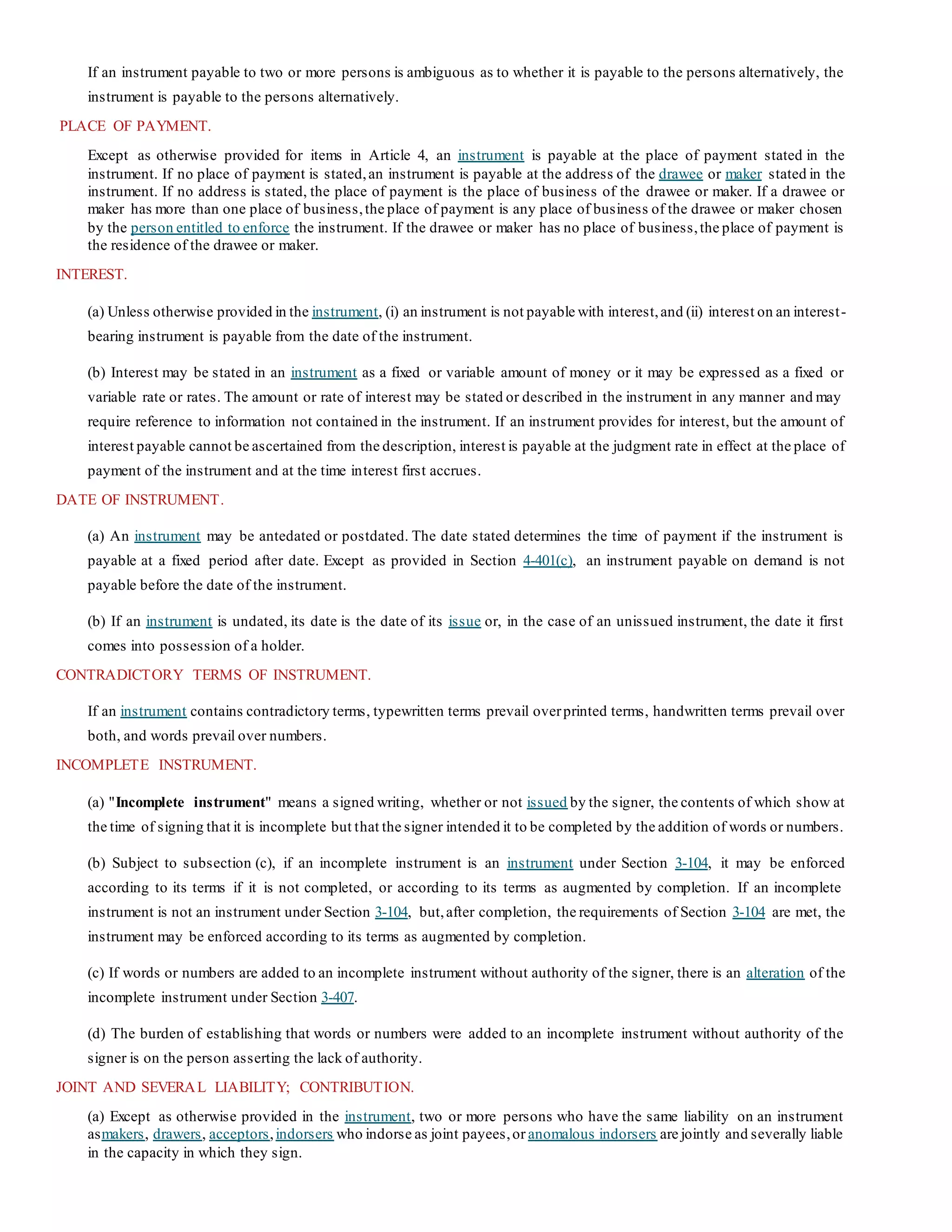This document defines key terms and concepts related to negotiable instruments under the Uniform Commercial Code. It discusses what constitutes a negotiable instrument, defines parties to instruments like makers, drawers and acceptors. It also covers issues like when an instrument is payable, to whom it is payable, places of payment, interest terms and incomplete instruments. The overall purpose is to provide a framework for understanding negotiable instruments governed by commercial law.
![NEGOTIABLE INSTRUMENTS
Part 1. GENERAL PROVISIONS AND DEFINITIONS
SHORT TITLE
This Article may be cited as Uniform Commercial Code -- Negotiable Instruments.
SUBJECT MATTER.
(a) This Article applies to negotiable instruments. It does not apply to money, to payment orders governed by Article 4A,
or to securities governed by Article 8.
(b) If there is conflict between this Article and Article 4 or 9, Articles 4 and 9 govern.
(c) Regulations of the Board of Governors of the Federal Reserve System and operating circulars of the Federal Reserve
Banks supersede any inconsistent provision of this Article to the extent of the inconsistency.
DEFINITIONS.
In this Article:
(1) "Acceptor" means a drawee who has accepted a draft.
(2) "Consumer account" means an account established by an individual primarily for personal, family, or household
purposes.
(3) "Consumer transaction" means a transaction in which an individual incurs an obligation primarily for personal,
family, or household purposes.
(4) "Drawee" means a person ordered in a draft to make payment.
(5) "Drawer" means a person who signs or is identified in a draft as a person ordering payment.
(6) [reserved]
(7) "Maker" means a person who signs or is identified in a note as a person undertaking to pay.
(8) "Order" means a written instruction to pay money signed by the person giving the instruction.The instruction may
be addressed to any person, including the person giving the instruction, or to one or more persons jointly or in the
alternative but not in succession. An authorization to pay is not an order unless the person authorized to pay is also
instructed to pay.
(9) "Ordinary care" in the case ofa person engaged in business means observance ofreasonable commercial standards,
prevailing in the area in which the person is located, with respect to the business in which the person is engaged.In the
case of a bank that takes an instrument for processing for collection or payment by automated means, reasonable
commercial standards do not require the bank to examine the instrument if the failure to examine does not violate the
bank's prescribed procedures and the bank's procedures do not vary unreasonably from general banking usage not
disapproved by this Article or Article 4.
(10) "Party" means a party to an instrument.
(11) "Principal obligor," with respect to an instrument, means the accommodated party or any other party to the
instrument against whom a secondary obligor has recourse under this article.
(12) "Promise" means a written undertaking to pay money signed by the person undertaking to pay. An
acknowledgment ofan obligation by the obligor is not a promise unless the obligoralso undertakes to pay the obligation.](https://image.slidesharecdn.com/negotiableinstruments1-150216211959-conversion-gate01/75/Negotiable-instruments-1-1-2048.jpg)
![(13) "Prove" with respect to a fact means to meet the burden of establishing the fact (Section 1-201(b)(8)).
(14) [reserved]
(15) "Remitter" means a person who purchases an instrument fromits issuerif the instrument is payable to an identified
person other than the purchaser.
(16) "Remotely-created consumer item" means an item drawn on a consumer account, which is not created by the
payor bank and does not bear a handwritten signature purporting to be the signature of the drawer.
(17) "Secondary obligor," with respect to an instrument, means (a) an indorser or an accommodation party, (b) a
drawer having the obligation described in Section 3-414(d), or (c) any other party to the instrument that has recourse
against another party to the instrument pursuant to Section 3-116(b).
NEGOTIABLE INSTRUMENT.
(a) Except as provided in subsections (c) and (d), "negotiable instrument" means an unconditional promise or order to
pay a fixed amount of money, with or without interest or other charges described in the promise or order, if it:
(1) is payable to bearer or to order at the time it is issued or first comes into possession of a holder;
(2) is payable on demand or at a definite time; and
(3) does not state any other undertaking or instruction by the person promising or ordering payment to do any act in
addition to the payment of money, but the promise or order may contain (i) an undertaking or power to give, maintain,
or protect collateral to secure payment, (ii) an authorization or power to the holder to confess judgment or realize on or
dispose of collateral, or (iii) a waiver of the benefit of any law intended for the advantage or protection of an obligo r.
(b) "Instrument" means a negotiable instrument.
(c) An order that meets all of the requirements of subsection (a), except paragraph (1), and otherwise falls within the
definition of "check" in subsection (f) is a negotiable instrument and a check.
(d) A promise or order other than a check is not an instrument if, at the time it is issued or first comes into possession ofa
holder, it contains a conspicuous statement,however expressed, to the effect that the promise or order is not negotiable or
is not an instrument governed by this Article.
(e) An instrument is a "note" if it is a promise and is a "draft" if it is an order. If an instrument falls within the definition
of both "note" and "draft," a person entitled to enforce the instrument may treat it as either.
(f) "Check" means (i) a draft, other than a documentary draft, payable on demand and drawn on a bank or (ii) acashier's
check or teller's check. An instrument may be a check even though it is described on its face by another term, such as
"money order."
(g) "Cashier's check" means a draft with respect to which the drawer and drawee are the same bank or branches of the
same bank.
(h) "Teller's check" means a draft drawn by a bank (i) on another bank, or (ii) payable at or through a bank.
(i) "Traveler's check" means an instrument that (i) is payable on demand, (ii) is drawn on or payable at or through a bank,
(iii) is designated by the term "traveler's check" or by a substantially similar term, and (iv) requires, as a condition to
payment, a countersignature by a person whose specimen signature appears on the instrument.
(j) "Certificate of deposit" means an instrument containing an acknowledgment by a bank that a sum of money has been
received by the bank and a promise by the bank to repay the sumof money. A certificate of deposit is a note of the bank.](https://image.slidesharecdn.com/negotiableinstruments1-150216211959-conversion-gate01/75/Negotiable-instruments-1-2-2048.jpg)



![(b) Except as provided in Section 3-419(e) or by agreement of the affected parties, a party having joint and several liability
who pays the instrument is entitled to receive from any party having the same joint and several liability contribution in
accordance with applicable law.
OTHER AGREEMENTS AFFECTING INSTRUMENT.
Subject to applicable law regarding exclusion of proof of contemporaneous or previous agreements, the obligation of
aparty to an instrument to pay the instrument may be modified, supplemented, or nullified by a separate agreement of the
obligor and a person entitled to enforce the instrument, if the instrument is issued or the obligation is incurred in reliance
on the agreement or as part of the same transaction giving rise to the agreement. To the extent an obligation is modified,
supplemented, or nullified by an agreement under this section, the agreement is a defense to the obligation.
STATUTE OF LIMITATIONS.
(a) Except as provided in subsection (e), an action to enforce the obligation of a party to pay a note payable at a definite
time must be commenced within six years after the due date or dates stated in the note or, if a due date is accelerated,
within six years after the accelerated due date.
(b) Except as provided in subsection (d)or (e), if demand for payment is made to the maker of a note payable on demand,
an action to enforce the obligation of a party to pay the note must be commenced within six years after the demand. If no
demand for payment is made to the maker, an action to enforce the note is barred if neither principal nor interest on the
note has been paid for a continuous period of 10 years.
(c) Except as provided in subsection (d), an action to enforce the obligation of a party to an unaccepted draft to pay the
draft must be commenced within three years after dishonor of the draft or 10 years after the date of the draft, whichever
period expires first.
(d) An action to enforce the obligation of the acceptorof a certified check or the issuer of a teller's check, cashier's check,
or traveler's check must be commenced within three years after demand for payment is made to the acceptor or issuer, as
the case may be.
(e) An action to enforce the obligation of a party to a certificate of deposit to pay the instrument must be commenced
within six years after demand for payment is made to the maker, but if the instrument states a due date and the maker is
not required to pay before that date, the six-year period begins when a demand for payment is in effect and the due date
has passed.
(f) An action to enforce the obligation of a party to pay an accepted draft, other than a certified check, must be commenced
(i) within six years after the due date or dates stated in the draft or acceptance if the obligation of theacceptoris payable at
a definite time, or(ii) within six years after the date ofthe acceptance if the obligation of the acceptoris payable on demand.
(g) Unless governed by other law regarding claims for indemnity or contribution, an action (i) for conversion of
aninstrument, for money had and received, or like action based on conversion,(ii) for breach of warranty, or (iii) to enforce
an obligation, duty,or right arising under this Article and not governed by this section must be commenced within three
years after the [cause of action] accrues.
NOTICE OF RIGHT TO DEFEND ACTION.
In an action for breach of an obligation for which a third person is answerable over pursuant to this Article or Article 4,
the defendant may give the third person notice of the litigation in a record, and the person notified may then give similar
notice to any other person who is answerable over. If the notice states (i) that the person notified may come in and defend
and (ii) that failure to do so will bind the person notified in an action later brought by the person giving the notice as to
any determination of fact common to the two litigations, the person notified is so bound unless after seasonable receipt of
the notice the person notified does come in and defend.](https://image.slidesharecdn.com/negotiableinstruments1-150216211959-conversion-gate01/75/Negotiable-instruments-1-6-2048.jpg)